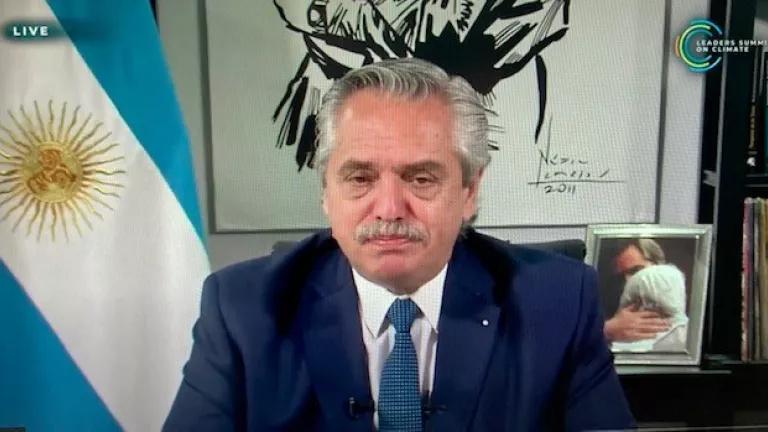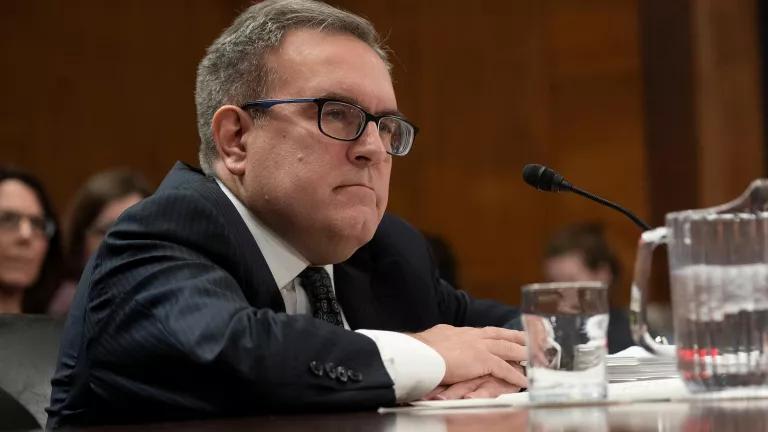Latin America at the Leaders Summit on Climate
The five Latin American countries that participated in the Leaders Summit on Climate – Argentina, Brazil, Chile, Colombia, and Mexico – displayed a broad range of ambition. Once again, some countries demonstrated their willingness to be climate action leaders while others seemed intent on cementing their position as climate laggards.

Five Latin American countries joined the Leaders Summit on Climate, the high-level summit of 40 world leaders that President Biden convened to underscore the urgency of ambitious action in the global fight against climate change. The Summit highlighted four main themes: raising ambition, investing in climate solutions, climate innovations, and economic opportunities from climate action. In the Summit’s opening session, leaders announced their countries’ current and new efforts to tackle global warming. The countries of Latin America in attendance—Argentina, Brazil, Chile, Colombia, and Mexico—displayed a broad range of ambition. Once again, some countries demonstrated their willingness to be climate action leaders while others seemed intent on cementing their position as climate laggards. Below we take a quick look at each announcement from Latin America.
Argentina
President Alberto Fernández firmly stated that climate and environmental action are in line with the country’s goals and convictions. He announced that Argentina is increasing its emission reduction target by 2 percentage points above the new Nationally Determined Contribution (NDC) that was submitted in 2020. This represents an overall emission reduction that is 27.7% deeper than the country’s original 2016 NDC. Argentina will also submit a National Adaptation and Mitigation Plan at COP26 that includes producing 30% of its electricity from renewables. It will also plan measures to boost efficiency in industry, transportation and construction, and reduce methane and short-lived climate pollutant emissions. Argentina will also combat illegal deforestation as an environmental crime and set a new budget for forest protection. Fernández also called for mechanisms to facilitate access to international climate finance including a system of debt swap for climate action. Finally, Fernández called for greater cooperation on climate action among countries in Latin America.
Our verdict? Still lagging, but with some promise.
While it’s encouraging that Argentina is continuing to increase the ambition of its NDC, the target is a long way from where it should be to align with a 1.5˚C world. Similarly, the renewable energy goal is a positive signal, but Argentina is still behind on meeting its current clean energy goal of 20%. Despite its clean energy commitments, Fernandez has pushed for investment in Vaca Muerta, a shale gas and tight oil project, that risks water contamination and pollution on top of greenhouse gas emissions from fracking. An key signal from Argentina that is still missing is a shift away from public support for Vaca Muerta. President Fernández’ call for greater Latin American coordination on climate and “solidarity” actions could be an opportunity to rally greater climate ambition in the region—particularly among the group of nations that are fossil fuels producers.

Brazil
President Jair Bolsonaro reiterated Brazil’s NDC targets: reducing emissions by 37% by 2025 and up to 43% by 2030. Bolsonaro also claimed that the country would achieve carbon neutrality by 2050 (ten years earlier than their previous deadline) and committed to eliminating illegal deforestation by 2030 with full and prompt enforcement of the already existing forest code. To achieve these goals, he argued, would require contributions from businesses, and collaboration from the international community—a “fair payment” for the environmental services provided to the rest of the world from Brazil’s biomes.
Our verdict? A change in tone, but still very much lagging.
As described further here, Bolsonaro reiterated outdated promises, vaguely mentioned strengthening environmental enforcement agencies (agencies that he has actively been dismantling) and asked for financial assistance from other countries based on Brazil’s 15 year track record which he has spent the last two years actively pulling apart. In addition, Brazil’s NDC targets use a carbon trick maneuver—they don’t change the percentage mitigation pledge but drastically change the baseline. In other words, by 2030 Brazil pledges to emit around 400 million tons more of CO2 equivalent than what they indicated in 2015. By moving the baseline numbers, Brazil can appear to make larger emission reductions than it actually does, all while the Amazon continues to burn.
Bolsonaro’s changing rhetoric (moving the carbon neutrality target by 10 years, or even acknowledging that climate change is real) is almost certainly a result of international pressure to end deforestation and increase Brazil’s commitments to tackling climate change. While his remarks were relatively vague, it still doesn’t take much critical thinking to be skeptical of anything Bolsonaro says in regard to the environment, considering his track record.

Chile
President Sebastián Piñera stated that Chile was determined to have a significant and positive impact in the fight against climate change. He highlighted that Chile’s vast renewable energy sources would allow it to decarbonize its energy matrix by 2040, achieve carbon neutrality by 2050, and become the most efficient green hydrogen producer in the world “thus helping other countries to decarbonize their own energy matrix.” President Piñera also highlighted the importance of protecting the world’s oceans, noting Chile currently protects over 43% of its marine exclusive economic zone. He specifically called on other countries to support Antarctic marine protected areas, and the first high seas marine protected area in the Nazca-Desventuradas Region, which has faced the threat of illegal fishing due to lack of enough surveillance and/or budget.
Our verdict? A regional climate ambition leader and a global oceans leader.
Chile has been growing into its role as a progressive climate leader in Latin America. As it moves forward with its clean energy transition it will be important to ensure that benefits are equitably shared with local communities and clean energy infrastructure does not result in negative social and environmental impacts. Securing a just transition for impacted communities as the country phases down coal will also help to create important lessons for its neighbors.
Chile has also played an important role as outgoing President of COP25 in underscoring the importance of the ocean as a climate regulator and opportunities for building resilience. It has also been a vocal advocate of the need to protect 30% of the world’ oceans by 2030.

Colombia
President Iván Duque reiterated Colombia’s commitments to a 51% emissions reduction by 2030 and a target of carbon neutrality by 2050. He highlighted some of the measures that Colombia is taking to achieve its targets, including a clean energy transition that will achieve 14% clean electricity by August 2022, the largest fleet of urban and cargo transport in the region, and a reforestation effort that aims to plant 180 million trees by August of 2022. The president also pointed to the importance of the Amazon rainforest, which makes up 35 percent of Colombia, and emphasized the role of payments for ecosystem services and the regional Leticia Pact for the Amazon. He also had made three calls to global leaders: support the leaders pledge for nature, capitalize multilateral financial institutions to enable climate transitions, and develop new and innovative mechanisms for debt for climate action swaps.
Our verdict? A regional climate ambition leader, but implementation details and a clear shift away from fossil fuels is necessary.
Colombia’s emission reduction target is ambitious and a strong political signal, but it is still unclear how the country will reach this target. Efforts to electrify the public urban transport system are very encouraging, but Colombia is still heavily dependent on fossil fuels and the government is a proponent of fracking to extend the country’s oil reserves. In addition, Colombia’s success in reducing emissions from the forestry sector will also require not just tree planting but putting an end to deforestation in the first place.

Mexico
President López Obrador outlined three proposals. First, he said that despite its recent oil discoveries, Mexico would limit crude oil production to domestic fuel needs and eliminate the practice of exporting crude oil only to import refined gasoline. Second, Mexico would modernize existing hydroelectric plants in order to displace coal and fuel oil in electricity. Third, he highlighted Mexico’s Sembrando Vida (Sowing Life) tree planting initiative which provides payments to rural workers who plant fruit or lumber trees on their land. This program has a target of planting trees on a million hectares, and he proposed its expansion in southeastern Mexico and Central America (with U.S. support) to cover an additional 3 million hectares. He suggested this third proposal could be linked to a regional migration plan that could eventually provide participants with a legal migration pathway to the U.S.
Our verdict? The clearest laggard in the region (frankly, we’re not even sure he understood what type of summit he’d been invited to).
As described in more detail here, President López Obrador’s proposal would actually mean higher crude oil production (as compared to current PEMEX levels) and increased use of dirty fuel oil in electricity generation. The result would be greater greenhouse gas emissions contributing to global warming and toxic air pollution for local communities exposed to the burning and refining of high-sulfur fuel oil. In addition, President López Obrador’s claim that boosting hydroelectricity would displace coal and fossil fuel based electricity is false— particularly if the modifications to the Electric Industry Law are fully implemented. Finally, his proposal to expand the Sembrando Vida initiative—a program that holds promise but has so far had resulted in mixed results—seems like an effort to distract from the fact that Mexico is simply not doing enough to reduce it energy sector emissions.






